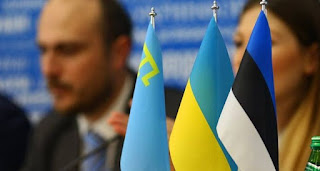
Estonia to Help Crimean Tatars Tell the World About the Occupation
By Paul Goble
The victims of almost 50 years of Soviet occupation themselves, Estonians are now preparing to help the Crimean Tatars, who have again come under Russian occupation. At a press conference in Kyiv, Mart Nutt, a member of the Estonian parliament, and Oliver Loode, the Estonian vice president of the United Nations forum on indigenous peoples, outline what they hope to do in cooperation with Mustafa Cemilev, the longtime leader of the Crimean Tatar national movement, Serhi Kostinsky, a Verkhovna Rada deputy who oversees television and radio policy, and the project’s Crimean Tatar producer Emine Dzheppar (Qha.com.ua, October 6).
The Estonians, Ukrainians and Crimean Tatars said that the project was being launched because the international community is too little informed about the problems of the Crimean Tatars under occupation and is not focused on the important reality that the Crimean Tatars are the indigenous population of the Ukrainian peninsula, a status which under international law gives them certain exclusive rights. They added that the three sides had agreed over the course of the next several months to develop a media strategy, one that will involve both several members of the Crimean Tatar Mejlis (de facto representative body of the Crimean Tatars), representatives of the media, and Estonian experts.
Emine Dzheppar said that “the goal of this group is the formulation of a strategy on the basis of which the project will be carried out over the next two years, one that will become a so-called road map for its realization.” The project will organize photographic exhibits in various countries around the world and at the United Nations. In addition, it will produce video materials, including both films and clips, about key problems that the Crimean Tatars now face.
The Estonians have one key advantage over the Crimean Tatars, and it may prove to be something from which the Crimean Tatars can profit from. Estonia was an independent state at the time of the beginning of the Soviet occupation, and the West, led by the United States, came up with its non-recognition policy based on the Stimson Doctrine that the international community cannot recognize any border changes achieved by force alone. As a result, the Estonians, like their two Baltic neighbors, have insisted that their states continued de jure throughout the occupation and that in 1991, they recovered their independence de facto rather than creating new states.
Unfortunately, the international community has not articulated the same policy with regard to Russian-occupied Crimea. While Western governments have said they will not end sanctions until Russia gives Crimea back, the reality is that at some point the sanctions regime will be lifted and Crimea will not have any legal support. Western non-recognition policy by articulating a principle allowed for variations in Western relations with Moscow but did not allow for any change concerning the West’s view of the continuing legal status of Estonia, Latvia and Lithuania.
It is extremely likely that the Estonian involvement in this joint project will lead the Crimean Tatars to appreciate the importance of a Western declaration of non-recognition of the Russian occupation of Crimea and press their friends and supporters to take a step equal in its legal standing to the 1940 declaration by Sumner Welles. If that happens, this small joint project will have a profound impact on international relations for years to come.




